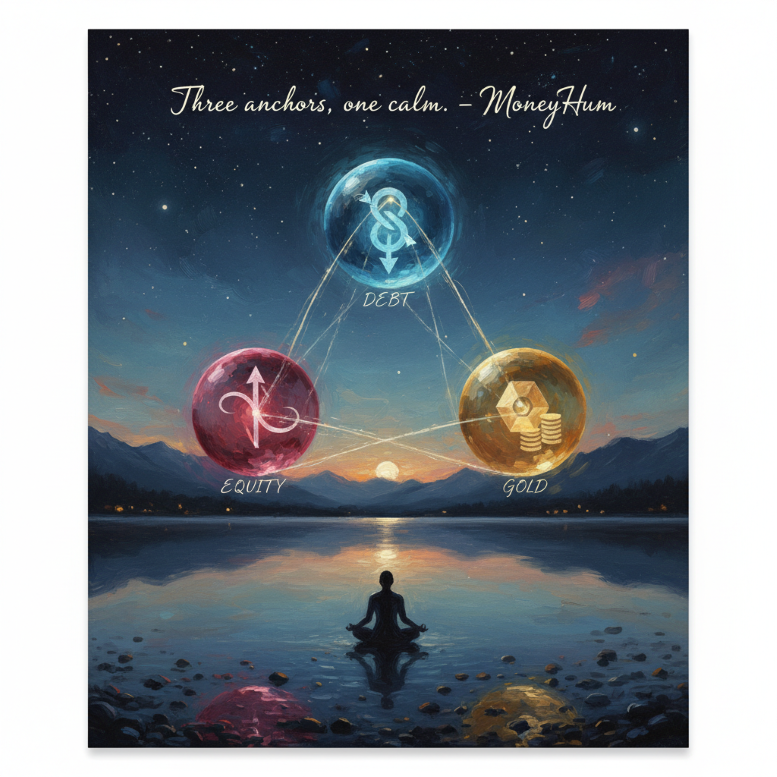Chapter 1: The Calm Beginning: Why Simplicity Builds Confidence in Investing
The Quiet Weight of Financial Noise
If you live and earn in India today, you already know how exhausting money can feel.
Everywhere you look, on Instagram, in WhatsApp groups, in YouTube thumbnails, someone is shouting about “the next multibagger,” “this hidden gem,” “this one small-cap mutual fund that beat the Nifty by 10% last year.”
It’s an endless storm of half-truths.
In that noise, something quieter often gets lost: your relationship with your own money.
Many of us enter the world of investing with a mix of curiosity and fear. A young professional in Bengaluru earning ₹70,000 a month wonders, “If I don’t start investing soon, am I falling behind?”
A mid-career engineer in Pune, juggling an EMI and child’s school fees, wonders, “Why does managing money still feel so uncertain, after all these years?”
It’s not lack of intelligence that holds us back. It’s mental clutter.
Simplicity is rare in modern finance because it doesn’t sell as well as excitement. Yet, paradoxically, it’s the one thing that has always worked. The real power of wealth creation lies not in chasing more, but in removing what doesn’t matter.
That’s what this chapter is about: slowing down enough to build the confidence to choose less, but better.

The Emotional Psychology of Simplicity
Let’s pause and ask a quieter question: Why does money make us anxious in the first place?
The answer is not purely financial. It’s deeply psychological.
Behavioral finance researcher Dr. Daniel Kahneman called it “loss aversion.” Our minds experience the pain of loss almost twice as strongly as the joy of gain. This means even when our portfolio goes up steadily for months, a single red day can undo our peace.
This emotion is universal, but in India it’s amplified by our cultural relationship with security. Many of us grew up watching our parents equate savings with safety. Money wasn’t a topic of freedom, it was a matter of survival.
So when you start investing, your mind carries both curiosity and caution. You want growth, but you also crave safety. You want to take risks, but not the kind that make your parents worry.
The three-fund portfolio honours both.
It says, “You don’t need to gamble to grow, and you don’t need to fear to be safe.”
Let’s slow this down.

A simple portfolio, three funds, clear roles, offers an emotional anchor. Each part carries a story:
- Equity Index Fund: The dreamer in you. The part that believes in India’s growth.
- Debt Fund: The guardian. The part that seeks peace when markets fall.
- Gold or International Fund: The quiet insurance. The part that balances when the world surprises you.
When you hold these together, you’re not just diversifying assets. You’re balancing emotions.
Understanding the Hidden Cost of Complexity
Here’s a small truth most investors learn late: complexity creates emotional volatility.
The more funds you hold, the harder it is to track, compare, and stay patient. Every new fund adds another performance line to worry about. Every piece of financial news suddenly feels “relevant.”
Your mental bandwidth becomes your most expensive investment.
Imagine this: you hold ten funds. The Nifty falls 2% one day. Five of your funds show losses. You feel compelled to “do something.” You open your app. You scroll through returns. You wonder whether to switch. You act out of fear.
Now imagine a portfolio with three funds. You already know what each one does. You know your equity fund will fluctuate. You know your debt fund is your stabilizer. You know your gold fund may move differently. You feel the same market fall, but now, you respond with awareness, not anxiety.
That awareness is confidence.
This is why many investors who build wealth slowly appear so calm. They aren’t calm because they know the future. They’re calm because they’ve reduced the number of moving parts in their system.
As the behavioural principle of “choice overload” suggests, too many options lead to decision fatigue and regret. The 3-fund portfolio removes this overload. It frees your mind from daily financial decision-making, the same way automation frees you from remembering every bill payment.
When simplicity enters, peace follows.
The Rational Ground: The Math Behind Calm
Now let’s give this clarity a plan.
The three-fund portfolio works not just because it feels simple, but because mathematically, it is efficient.
At its heart is a principle called asset allocation: how you divide your money across equity, debt, and diversification assets like gold or international exposure.
Let’s see a real-world example.
Suppose Riya, 28, starts investing ₹10,000 per month.
She builds her portfolio like this:
| Asset | Fund Type | Allocation | Expected Long-Term Return (per annum)* |
|---|---|---|---|
| Equity Index Fund (Nifty 50) | Growth | 60% | 11% |
| Short-Term Debt Fund | Stability | 30% | 6% |
| Gold ETF / International Fund | Diversifier | 10% | 7% |
- Source: Historical category averages, AMFI India (2020–2024). Returns are indicative, not guaranteed.
Over 20 years, this mix gives her a blended expected return around 9.3% per year, with lower volatility than 100% equity.
Now compare this to someone who invests entirely in equities. The expected return might be higher (say 11%), but the portfolio could experience 35–40% temporary declines during bear markets. The 3-fund structure limits that emotional pain, often keeping drawdowns below 20–25%.
That’s not just math, that’s peace.

Because when markets fall, you need a portfolio you can emotionally stay invested in. A slightly lower return you can stick with for 20 years beats a higher-return portfolio you abandon in 3.
This is how rational clarity meets emotional truth.
How Simplicity Compounds Confidence
Let’s take this deeper, beyond numbers.
Confidence in investing isn’t built by watching your returns. It’s built by keeping promises to yourself, month after month, SIP after SIP.
Every time you invest in your three funds, you remind yourself: I am doing the right thing, the simple thing, the sustainable thing.
This quiet consistency begins to rewire your financial identity.
You stop seeing yourself as someone who “tries to invest.”
You begin seeing yourself as an investor who trusts their system.
That system is what builds peace.
Over time, you’ll notice this calm confidence spilling into other parts of life. You’ll stop reacting impulsively to news. You’ll spend more intentionally. You’ll measure progress not by how fast your money grows, but by how steady your inner state feels.
As MoneyHum explored in Financial Anxiety Is the Modern Disease, emotional calm is the true measure of financial maturity. Simplicity is not naive, it’s wisdom in action.
The Gentle Discipline of Letting Go
There’s a paradox in wealth-building: the more you try to control the outcome, the more anxious you become.
The best investors don’t chase every market move. They design systems that work without constant supervision. They understand that the discipline of letting go, of over-checking, over-analyzing, over-tweaking, is not laziness, but mastery.
If you’ve ever felt like you “don’t know enough” to invest, remember this: simplicity doesn’t mean ignorance. It means you trust in principles that have survived time.
You don’t need to predict the next Sensex high. You just need to participate in India’s long-term story, steadily, peacefully, automatically.
That’s what this portfolio offers: participation without panic.
As you’ll see in the next chapter, risk doesn’t have to mean fear, it can mean understanding.
Emotional Reflection: A Quiet Closing
Pause here for a moment. Imagine your financial life five years from now.
You open your portfolio dashboard. You see three funds.
You know exactly why each one exists. You know your SIP date, your goal, your time horizon. You see growth, small corrections, and a steady pattern of calm.
You feel something you haven’t felt in years: clarity.
This is what simplicity gives you: not just higher returns, but higher peace.
You don’t need to chase quick profits anymore (see Why You Keep Chasing Quick Profits).
You’ve replaced chaos with structure. Impulse with intention. Anxiety with awareness.
That’s where confidence begins, not from markets, but from within.
In the next chapter, we’ll explore the inner structure of this calm: the psychology and math of risk, balance, and long-term resilience.
Because to truly trust simplicity, you must understand what protects it.
Chapter 2: Understanding Risk and Balance: The Psychology and Math of Asset Allocation
When Growth Feels Scary
Most people don’t fear losing money.
They fear uncertainty: that strange emptiness between control and chaos.
You invest ₹10,000 every month in your SIP, and then you see the market fall by 15%. Your brain knows it’s “temporary.” But your stomach feels otherwise. That pit of worry isn’t logic, it’s emotion.
In India, where stability is often celebrated more than experimentation, our emotional wiring around risk is complex. Many of us were taught to measure safety by the number of FDs we hold, not by how well our assets are diversified.
So when you move from saving to investing, something shifts inside. You’re not just learning finance, you’re learning trust.
Trust in time.
Trust in compounding.
Trust in yourself.

Let’s slow this down and look closer at what risk truly means, not the scary kind we imagine, but the kind we can understand and work with.
What Risk Really Is (And Isn’t)
Risk is not the same as loss. It’s the possibility of fluctuation. It’s what allows returns to exist. Without risk, there’s no reward, only stagnation.
Think of it this way: when you put your money in a fixed deposit, your return is fixed at maybe 6–7%. You’ve traded away all volatility for complete certainty. That’s fine for short-term goals. But over long periods, that same safety quietly becomes a risk, the risk of erosion by inflation.
If inflation averages 5%, and your FD earns 6%, your real growth is just 1%.
Your money feels safe today, but its purchasing power is shrinking tomorrow.
Equity, on the other hand, swings widely, sometimes violently, but across long stretches of time, it has historically grown faster than inflation. The volatility you fear today becomes the fuel for your future stability.
So when you hear the word risk, try replacing it with movement.
Movement you can measure. Movement you can balance.
That’s what the 3-fund portfolio helps you do: turn movement into balance.
The Psychological Side of Risk
Every investor has two selves inside them:
- The logical self, who plans for 20 years.
- The emotional self, who panics in 20 minutes.
Both are real, and both deserve care.
If you ever felt ashamed for reacting to market noise, stop. You’re human.
Behavioral finance calls this the “fight-or-flight” response; our brain’s ancient mechanism to survive danger. In the stock market, a red number can trigger the same stress signal as a physical threat.
Here’s the key: while you can’t remove emotion, you can design around it.
That’s what balanced investing does; it respects both sides of your mind.
The equity part gives your logical self growth. The debt part soothes your emotional self with predictability. The gold or international part adds insurance against shocks.
This is not just diversification. It’s emotional architecture.
It allows your mind to rest even when markets move. That rest, that sense of “I know what’s happening and why,” becomes your greatest financial advantage.
If you’ve ever struggled with this emotional seesaw, you might enjoy Financial Anxiety Is the Modern Disease, which explores how stress around money can quietly shape our entire lives.
The Mathematical Spine of Balance
Let’s now bring numbers to emotion.
In any portfolio, what truly matters is how assets move relative to each other.
This relationship is measured by something called correlation.
- A correlation of +1 means two assets move in the same direction, always.
- A correlation of 0 means they move independently.
- A correlation of –1 means they move in opposite directions.
Now, look at how our three funds behave:
| Asset | Typical Correlation to Equity | Purpose |
|---|---|---|
| Equity Index Fund | +1.0 (it is equity) | Growth |
| Short-Term Debt Fund | –0.2 to 0.1 | Stability |
| Gold or International Fund | –0.1 to 0.3 | Diversification |
(Approximate correlations based on 5-year category averages from NSE and AMFI data, 2019–2024.)

The beauty here is subtle: when equity falls sharply, debt often holds steady or rises slightly. Gold may even go up. This interplay cushions the blow.
In simple words: when one part stumbles, the other holds your hand.
Mathematically, this reduces portfolio volatility, measured by standard deviation.
If pure equity has a volatility of around 18–20%, a balanced 3-fund mix might fall to 11–12%, while keeping most of the returns intact.
You’re not giving up much performance, you’re gaining emotional durability.
Emotional durability is what keeps your SIP alive for 20 years, not your excitement on day one.
Risk Tolerance: Your Personal Equation
Every person’s relationship with volatility is different.
For a 25-year-old with decades to invest, a 30% drop is uncomfortable but tolerable. For a 42-year-old saving for their child’s education, even a 10% drop feels personal.
So, instead of copying someone else’s allocation, you need to find your risk comfort zone.
A simple way to estimate it:
Subtract your age from 100; the result is roughly the percentage of your portfolio that can go into equity.
Example:
- Age 28 → 72% equity
- Age 40 → 60% equity
- Age 50 → 50% equity
The rest goes into debt and gold.
It’s not perfect, but it gives you a starting structure that aligns with both your math and your mind.
Let’s bring this alive through two lives:
Aarav, 27: He’s just started his first job, earns ₹60,000/month, and can invest ₹8,000. He chooses 70% equity, 20% debt, 10% gold. His priority is growth and habit-building.
Meera, 39: She earns ₹1.2 lakh/month, supports a family, and wants calm consistency. She chooses 60% equity, 30% debt, 10% gold. Her goal is peace, not outperformance.
Same portfolio structure. Different emotional centers.
That’s what makes the 3-fund method universal; it bends gently to each life stage.
How Balance Protects You
Let’s test the idea with a real example.
During the COVID crash in March 2020, the Nifty 50 Index fell around 38% in a matter of weeks. Debt funds, on the other hand, dropped barely 1–2%. Gold rose nearly 25% over the same year.
If you had a 60-30-10 portfolio, your total decline would have been around 18–20% instead of 38%.
The psychological difference between a 20% and a 38% fall is massive; one feels temporary, the other feels catastrophic.
That smaller drawdown doesn’t just preserve money, it preserves trust.
Trust keeps your SIP running.
This is how the 3-fund portfolio quietly transforms fear into faith, not by predicting markets, but by designing a structure that works through them.
If you want to understand why patience beats panic mathematically, read The Path to Real Wealth: Why Patience and Compounding Beat Shortcuts. It’s the emotional complement to what you’re learning here.
The Role of Rebalancing
Balance isn’t a one-time act. It’s a rhythm.
Every year, your asset weights drift; equities rise faster, debt lags, or gold spikes. Over time, your portfolio starts tilting toward whichever asset performed best recently. That can quietly increase your risk without you noticing.
Rebalancing means gently bringing your portfolio back to its original mix, say 60-30-10, once a year.
How?
You sell a little from what’s grown too fast and add to what’s lagged.
It sounds counterintuitive, but this discipline turns volatility into opportunity. You’re automatically buying low and selling high, without emotion.
Let’s illustrate:
Suppose your ₹10 lakh portfolio grows unevenly; equity jumps to ₹7 lakh, debt stays ₹2.8 lakh, gold ₹0.5 lakh. Now your mix is 70-28-5.
You rebalance by selling ₹1 lakh of equity and moving it into gold and debt. The math restores balance, but more importantly, the act restores peace of mind.
You’re no longer chasing returns, you’re maintaining alignment.

That’s what the 3-fund system teaches you: peace is not the absence of movement, but the mastery of rhythm.
Risk, Emotion, and Identity
As you live with your portfolio, you’ll notice something profound.
Your feelings about volatility start to shift. What once triggered panic now invites curiosity. What once felt like risk begins to feel like rhythm.
That’s not just emotional maturity, it’s identity transformation. You’ve become someone who can hold discomfort without losing direction.
In How to Measure Real Progress in Life, we explored how true progress isn’t about speed or comparison. The same holds here. Financial maturity is not how fast your portfolio grows, but how calmly you grow with it.
When you stop seeing corrections as “crashes” and start seeing them as “rebalancing opportunities,” you’ve crossed a quiet threshold, from investor to steward.
Reflection: Balance as a State of Mind
We often chase balance as a thing to achieve: the perfect mix, the perfect ratio, the perfect fund. But balance is not a fixed point. It’s a living dialogue between your goals, your emotions, and your numbers.
The three-fund portfolio becomes your language for that dialogue.
It whispers, “You can grow and stay safe. You can move and stay calm.”
As you carry this philosophy forward, the act of investing becomes more than financial. It becomes spiritual: a practice in patience, humility, and trust.
So, take a deep breath.
You don’t need to know what the Sensex will do next week.
You just need to keep showing up: with awareness, consistency, and quiet faith.
In the next chapter, we’ll bring this philosophy to the ground: choosing the right funds, setting up SIPs, understanding taxes, and designing an actual 3-fund portfolio that works for your life.
Chapter 3: Designing Your Own 3-Fund Portfolio in India: From Theory to Reality
Where Clarity Turns Into Movement
By now, you’ve understood the emotional and mathematical rhythm of a simple 3-fund portfolio. You know why simplicity calms the mind. You know how balance protects the heart.
Now comes the part where this wisdom becomes real; where thought turns into structure.
This chapter is not about chasing the best fund. It’s about designing a system that fits your life: your goals, your salary, your time horizon, your temperament.
The best portfolio is not the one that earns the highest return, it’s the one you can live with, year after year, without losing sleep.
Let’s build that, step by step.
The Core Philosophy of the 3-Fund Portfolio (India Edition)
The classic 3-fund idea originated in the United States, often described as “Total Stock Market + Total Bond Market + International Stock Market.” But India’s financial ecosystem and tax rules require a gentle reimagination.
Here’s how the India-specific version looks:
| Fund Type | Purpose | Typical Allocation | Examples (Category level, not product advice) |
|---|---|---|---|
| Equity Index Fund (Nifty 50 / Nifty Next 50 / Sensex) | Long-term growth | 50–70% | Nifty 50 Index Fund, Nifty Next 50 Index Fund |
| Debt Fund (Short-Term / Gilt / Corporate Bond) | Stability, regularity | 20–40% | SBI Short Term Debt Fund, Axis Treasury Advantage Fund, Bharat Bond ETF |
| Diversifier (Gold ETF or International Index Fund) | Protection during crisis | 10–15% | Nippon India Gold ETF, Motilal Oswal Nasdaq 100 Fund of Fund |
This combination covers nearly every type of risk and opportunity an Indian investor faces: growth, stability, and global uncertainty.
Let’s unpack each.
The Growth Engine: Equity Index Fund
Your equity fund is the beating heart of your wealth creation. It captures the compounding power of India’s economic growth.
Why Index Funds?
Because they are simple, transparent, and low-cost.
Instead of trying to outsmart the market, they mirror it.
According to AMFI data (2024), the average expense ratio for an index fund in India is 0.15%–0.30%, compared to 1.5%–2% for many active funds. That difference, a quiet 1% every year, compounds massively over 20 years.
Let’s do the math.
If you invest ₹10,000 per month for 20 years at an 11% annual return (typical for equities), you’ll have about ₹75 lakh.
Now, reduce that return by just 1% (due to higher expense ratio): the corpus drops to about ₹66 lakh.
That’s ₹9 lakh lost; not to bad performance, but to cost.
That’s why simplicity wins. Index funds are quiet performers. They require no prediction, no tinkering, no luck, just discipline.
Choosing Between Nifty 50 and Nifty Next 50
- Nifty 50: Large, stable companies; the foundation of your portfolio.
- Nifty Next 50: Slightly more aggressive mid-large companies; more volatility, higher potential return.
Many investors blend both, say 70% Nifty 50 and 30% Nifty Next 50, to balance stability with growth.
This fund is the part of your portfolio that speaks to your future self, the one who believes in the long arc of India’s progress.

The Anchor: Debt Fund
While equity is your engine, debt is your steering wheel. It keeps you grounded when markets shake.
Debt funds invest in government securities, corporate bonds, or treasury bills. Their goal isn’t high return, it’s consistency.
How to Choose a Debt Fund
Look for:
- Short duration (less sensitivity to interest rate changes)
- High credit quality (AA or above)
- Reasonable expense ratio (<0.5%)
- Track record of at least 3–5 years
Popular Categories for Stability
- Short Duration Fund: Balanced risk and liquidity
- Corporate Bond Fund: Slightly higher yield, moderate risk
- Gilt Fund (10-year Constant Maturity): Pure government bonds, ideal for long-term goals
In India, interest income from debt funds is taxed at your slab rate (post-2023 rule change). So they work best when held in tax-sheltered accounts like EPF, NPS, or within long-term goals where the impact is small compared to peace of mind.
Debt is not exciting, but it’s essential. It’s the voice that whispers, “You don’t have to be brave every day.”
The Shield: Gold or International Fund
When crises hit (pandemics, wars, inflation shocks) equity wobbles. That’s when diversification shows its worth.
In India, gold has a centuries-old emotional and economic role. Beyond culture, it’s statistically proven to protect during equity drawdowns.
Between January and March 2020, as the Nifty 50 fell 38%, gold prices in INR rose over 20%. That’s correlation in action.
You can hold gold through:
- Gold ETFs (easy, low-cost)
- SGBs (Sovereign Gold Bonds) for 8-year holding with 2.5% interest and tax-free maturity
- Gold Mutual Funds (for simplicity via SIP)
Alternatively, you can use an International Index Fund, like one tracking the Nasdaq 100 or S&P 500. These add exposure to global innovation and act as a currency hedge, since they benefit if the rupee depreciates.
Either way, keep this portion modest (10–15%). It’s not there to win, it’s there to protect.

Turning Structure into System: SIPs and Automation
The most powerful wealth-building act is not choosing funds, it’s continuing the SIP when it feels uncomfortable.
Set up monthly SIPs for all three funds, preferably on the same date. This creates a rhythm; a financial heartbeat. Over time, this rhythm rewires how your brain experiences volatility.
For instance:
- Equity Fund SIP: ₹6,000
- Debt Fund SIP: ₹3,000
- Gold Fund SIP: ₹1,000
Now, instead of reacting to markets, you’re participating through them.
Automation tools like UPI AutoPay make this seamless. You can explore UPI Autopay: The Quiet Revolution of Effortless Savings and Investing for practical guidance on setting this up.
Automation turns discipline into peace.

You no longer depend on motivation; your system moves even when you don’t.
Building a Dashboard: Your Mind’s Mirror
Once your portfolio is in place, you need visibility, not to overcheck, but to stay connected.
A simple dashboard (even an Excel or app-based tracker) showing:
- Total invested amount
- Current value
- Allocation (Equity/Debt/Gold)
- Annualized return
- SIP status
This visual feedback helps anchor your patience. It transforms abstract growth into tangible reassurance.
As we explored in Your Financial System Needs a Dashboard: Not Just Dreams, structure isn’t about control, it’s about awareness.
When you can see your system working, you stop needing to tinker.
You become a designer, not a gambler.
Tax Awareness: The Quiet Side of Efficiency
Let’s keep this calm and factual; taxation is not scary when understood.
- Equity Funds:
- Held >1 year: 10% LTCG tax on gains above ₹1 lakh per year.
- Held <1 year: 15% STCG tax.
- Debt Funds:
- From April 2023, taxed at your income slab rate, regardless of holding period.
- Gold ETFs:
- Same as debt funds.
- SGBs:
- Tax-free at maturity after 8 years.
To reduce tax drag:
- Hold equity funds for long horizons (5+ years)
- Use SGBs instead of short-term gold ETFs if you can stay invested
- Keep rebalancing minimal to avoid unnecessary capital gains
Tax efficiency is not about loopholes, it’s about alignment between time and intent.
How to Start: The First 60 Days
For many readers, this is the hardest part: getting started. Not because of risk, but because of inertia.
Here’s a gentle 60-day roadmap:
Week 1–2:
- Open a clean, clutter-free mutual fund account or brokerage (Direct Plan, Growth Option).
- Learn how SIP setup works.
Week 3–4:
- Choose your three funds using AMFI or fund-house websites.
- Read their factsheets for consistency and simplicity.
- Allocate based on your age and comfort: 60-30-10 or 70-20-10.
Week 5–8:
- Start SIPs on a fixed date (say the 5th of each month).
- Track your first month through your dashboard.
- Do nothing else. Just observe.
That last part, doing nothing, is the real test.
When your first small dip arrives, stay still. You’ve already built the safety inside your design.
You’ll find, slowly, that calm is a skill.
That skill compounds faster than money.
Reflection: When Simplicity Meets Self-Trust
The true power of this 3-fund portfolio isn’t just diversification, it’s psychological liberation.
Once you design your system, money stops being a daily drama. It becomes a quiet background process supporting your real life: your work, your family, your peace.
When that happens, you stop asking, “What should I buy next?” and start asking, “What kind of life am I building?”
That’s when you’ve crossed from confusion to clarity.
As you walk this journey, remember what we explored in The Hidden Cost of Constant Hustle: doing less can often earn you more, not just financially, but emotionally.
Simplicity, practiced daily, becomes strength.
Strength, when paired with stillness, becomes wisdom.
Chapter 4: The Inner Wealth: Building Patience, Systems, and Peace with Your Portfolio
When the Portfolio Becomes a Mirror
At some point, every investor realises that their portfolio isn’t just a collection of funds, it’s a reflection of who they are becoming.
It reveals your fears, your discipline, your ability to wait, and your ability to let go. It shows what you value more: excitement or peace.
By now, you’ve built your three-fund portfolio: equity for growth, debt for stability, gold or international for balance. You’ve automated your SIPs. You’ve created your dashboard. The system is in place.
Then something subtle happens.
You stop needing to check your portfolio every week.
You start trusting it like an old friend.
This shift, from control to trust, is what this final chapter is about. True wealth is not measured in returns. It’s measured in calm.
The Patience Curve: How Time Rewards Stillness
Let’s start with a truth that few people fully believe until they’ve lived through it:
Compounding doesn’t reward brilliance. It rewards endurance.
If you invest ₹10,000 per month for 30 years at an average return of 9%, you’ll have about ₹1.7 crore.
But if you stop after 20 years, you’ll have ₹75 lakh, less than half.
That last decade, the one where most people get restless, produces more wealth than the first two combined.
Why? Because compounding is exponential, not linear. It moves slowly at first, then suddenly fast. Like bamboo that grows underground for years before rising tall in months.
To reach that stage, you need emotional patience: the ability to stay invested through boredom, not just through crashes.
Most investors prepare for bear markets. Few prepare for boredom.

Yet boredom is the bigger killer of compounding.
In a world obsessed with newness, boredom feels like failure. But in investing, boredom is proof of success. It means your system is working quietly.
If you find yourself tempted to tweak or chase returns, pause and revisit Why You Keep Chasing Quick Profits. It’s a mirror for every restless investor’s heart; a reminder that enoughness is strength.
The Psychology of Staying Still
To stay patient, you must first understand what disturbs patience.
Most of it isn’t market volatility. It’s comparison.
You see a friend post their 40% gain in a mid-cap fund and wonder if you’re being too conservative. Or you read about Bitcoin or small caps and start doubting your own path.
That’s not financial weakness, that’s human nature. Behavioral scientists call it social benchmarking; our mind’s tendency to measure satisfaction by comparison, not by absolute truth.
Here’s the antidote: clarity of purpose.
When you know why you invest, not just where, the noise loses its hold.
Your portfolio becomes personal, not performative.
Write this down somewhere near your workspace:
“My portfolio is designed for peace, not praise.”
When you internalise that, external noise begins to fade.
You stop chasing, and start tending, like a gardener who trusts that time will do its quiet work.
Systems Thinking: Your Invisible Ally
If emotion is what derails investors, systems are what protect them.
A system means you’ve designed automatic behaviors that don’t depend on mood.
Let’s revisit the pillars you’ve already built:
- Automated SIPs → So discipline happens without decision.
- Annual Rebalancing → So balance is maintained without bias.
- Visual Dashboard → So awareness replaces anxiety.
- Defined Goals → So purpose replaces panic.
These systems form your personal financial nervous system. They respond to volatility calmly, without emotional spikes.
You can refine these systems further through small rituals:
- Review your portfolio once every quarter, not every day.
- Rebalance once a year, ideally at a fixed date like 31st March.
- Increase SIPs once a year with your salary increment (5–10%).
Each ritual builds rhythm. Rhythm builds peace.
In Your Financial System Needs a Dashboard: Not Just Dreams, we explored why structure is freedom. This is the moment you begin to live that truth.
When your system is complete, your emotions can finally rest.
The Mathematics of Staying Invested
There’s a small equation that silently governs long-term success:
Wealth = (Return × Time × Consistency) – (Emotional Interruptions)
Emotional interruptions (panic selling, frequent switching, missing SIPs) reduce returns more than fees or taxes ever will.
Let’s quantify this.
Assume two investors, both investing ₹10,000/month for 25 years.
- Asha stays invested calmly, averaging 9% returns.
- Rohan exits for 2 years every time the market crashes, missing 5 good years.
At the end of 25 years:
- Asha: ₹1.06 crore
- Rohan: ₹76 lakh
Same funds, same SIP, same returns, different emotions.
The 30-lakh difference is the price of impatience.
That’s why the quietest investor often ends up the richest.
Peace, it turns out, has a very high ROI.
Reframing Volatility: From Threat to Teacher
When the next market fall comes, and it will, your instinct will whisper, “Should I stop?”
That’s when you must remember: volatility isn’t the market punishing you. It’s the market testing you.
Each correction is a classroom where you practice your philosophy.

Here’s what to do when markets fall:
- Keep SIPs running; this is when units are cheaper.
- Avoid looking at returns for a few months.
- Focus instead on your behavior score: “Did I stay consistent?”
After every crash in Indian market history, from 2008 to 2020, patient investors who continued SIPs saw strong recoveries within 3–5 years.
The pattern repeats because human behavior repeats.
As explored in The Path to Real Wealth, true compounding happens not in your portfolio, but in your mind.
Each time you stay still during chaos, your future self grows stronger.
Redefining Success: Beyond Numbers
Somewhere between SIP charts and CAGR calculators, we forget that money is a means, not an identity.
Real wealth is when your time, attention, and peace are all under your control.
Ask yourself:
- Does your portfolio reduce stress or increase it?
- Does it buy time for what truly matters: family, health, purpose?
- Does it align with the life you quietly want, not the one the internet sells?
If you answer yes to these, you are already wealthy.
You don’t need to prove it to anyone.
In How to Measure Real Progress in Life, we explored how peace can be a form of profit. The 3-fund portfolio embodies that truth: fewer moving parts, fewer worries, more life.
The Gentle Art of Reviewing Yourself
Every year, alongside rebalancing your funds, review yourself.
Ask:
- Did I stay patient during volatility?
- Did I increase my SIP as my income grew?
- Did I avoid unnecessary new funds or market fads?
- Did I stay kind to myself when I made small mistakes?
This reflection builds financial maturity faster than any course.
Remember, your goal is not perfection, it’s progress with peace.
Celebrate the small wins:
- A year of uninterrupted SIPs.
- A calmer response to a red market.
- A month where you didn’t check your portfolio at all.
These are not trivial; they are milestones of emotional compounding.
Integrating the Inner and Outer Wealth
If you zoom out now, your financial life begins to look like a living system:
- Outer Wealth: Your funds, portfolio, assets.
- Inner Wealth: Your patience, discipline, self-awareness.
Both grow together, or not at all.
Your outer system compounds in numbers.
Your inner system compounds in trust.
One day, you realise something quiet and powerful: you no longer invest for freedom, because you already feel free.
That’s when you’ve reached the point where money stops being a goal and becomes a tool. A simple, honest tool for living well.
Reflection: The Calm After Building
Take a deep breath.
Look back at what you’ve built:
- A three-fund portfolio that reflects balance.
- A system that runs on automation, not anxiety.
- A mindset that sees volatility as rhythm, not chaos.
This isn’t just financial planning. It’s emotional engineering.
You’ve built not only a portfolio, but a philosophy; one that can sustain you through decades of change.
Let your system work now.
Check less. Live more.
When the world tempts you with noise again, remember this simple sentence:
“Peace is my profit.”
That’s the MoneyHum way: rational, reflective, grounded in truth.
FAQs
Can I modify the three-fund portfolio later?
Yes. As your goals or income change, you can adjust allocations once a year. The philosophy stays the same: equity for growth, debt for safety, and gold/international for balance.
What if I already hold many funds?
Gradually simplify. Exit duplicate or overlapping funds over 12–18 months to avoid tax hits. Aim for three core funds that do 90% of the work.
How much should I invest monthly?
Start with 20–30% of your monthly income. The exact number matters less than the habit, as detailed in Build a Strong SIP Habit: Your Simple 12-Month Plan for Beginners.
Is gold really necessary?
It’s optional but emotionally useful. Gold or international exposure cushions crises and reduces volatility. Even a 10% allocation can preserve peace.
What if I panic during market falls?
Revisit your dashboard. Review your original plan. Re-read Financial Anxiety Is the Modern Disease. Remember: your system is designed for storms.
How often should I check my portfolio?
Once every quarter is enough. Over-monitoring breeds anxiety. Trust the rhythm you’ve built.
The Quiet Ending
Building wealth is not about getting rich quickly. It’s about learning to stay still long enough for compounding, both financial and emotional, to do its work.
The 3-fund portfolio is not an investment strategy. It’s a mindset practice.
A daily whisper of simplicity, a quiet architecture of calm.
When you finally stop chasing, you start receiving: not just returns, but peace.
That’s real wealth.
That’s your calm revolution.

If you’ve read this till the end, thank you❤️
With love,
Your Dearest Friend,
Chitraansh







